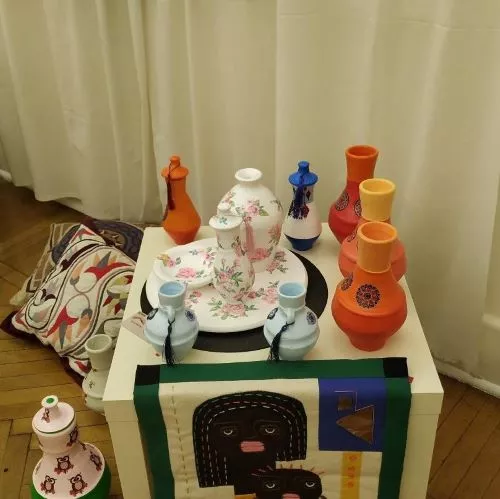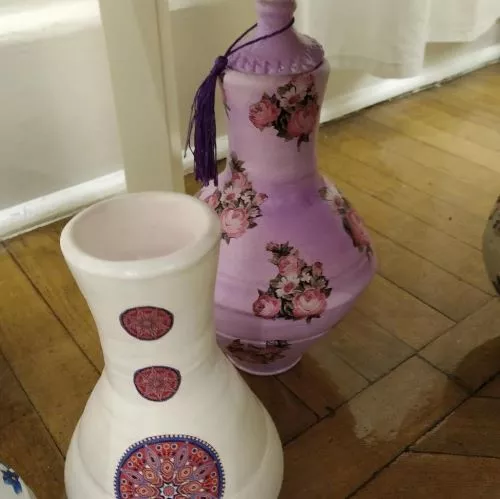Her upbringing in a house supportive of culture and art contributed to the multiplicity of her literary and artistic talents. The plastic artist, Amani Mahfouz, decided to use her talent to paint on pottery tiles and turn them into beautiful decorative pieces of art that are not characterized by stylization. As she launched a brand called “Kalil Misr” in an attempt to revive Egyptian necklaces and present them inside homes as antiques that express the spirit of Egyptian art.
Family support
Amani talks about her relationship with art and literature, telling Bab Misr: “My relationship with art began at an early stage in my life. As my family opened to me all forms of knowledge as a result of the constant support, which is the point that I took advantage of, and this atmosphere helped me to taste literature and the arts as well as understand the value of reading.”
And she continued: My family gave me the opportunity to go to the municipal library in Alexandria. Books were available and I was up to date on all that was new in terms of books. However, in the same context, the municipal library contained within it a hall for plastic art, and it hosted several exhibitions. Hence, I began to relate to plastic art. So I am fortunate that my family has developed and supported my talent.
Amani Mahfouz products
Inspirational experience
During middle school, Amani started writing poetry. Her teachers encouraged her to continue. And here she decided to go to the Palaces of Culture to develop her talent. I made sure to follow the available literary meetings and seminars.
She says: “I have presented in many poetry competitions, and in parallel with writing, I have begun to practice plastic art effectively. But I stopped writing as a result of the pressures of life, and then I decided to complete what I started again and return to writing. And my poetic career began writing colloquial poetry.
And she continued: I tried to create different things to present, so I presented the “At the Shop Door” experience, in which I was keen on the idea of writing on the street, and this experience was inspiring and affected many.
Amani loved Juha's stories, as she wished to buy a painting of him that she always saw while walking in one of the streets of Alexandria. Instead of buying the painting, she decided to make her own using a needle and thread.
She says: “I agreed with the artist Khaled Abdel-Meguid, who implemented a workshop to teach Khayameya to help me draw on canvas. Indeed, the first painting, “Juha,” which I have always loved, was executed. Painting on canvas was difficult and tiring, but I decided to go through the experience that I loved so much. From there, I decided to experiment with plastic drawing on sketches, and participated through them in various exhibitions.”
accurate process
Amani mentions that she also had a new experience. As she admired the vocabulary of the rich and varied Egyptian heritage; Since her childhood, she loved the Egyptian heritage. Especially “the few.” As a result of her continuous drawing practice, she decided to revive the Egyptian heritage once again, in order to adapt it to the requirements of the times.
She says, “I started the process of employing fine art by painting on pencils. Although it is difficult to draw on a few, I decided to experiment, as it is not flat and therefore the process of drawing on it is difficult, due to the curves on it. And I began to use unrefined colors, and used the art of decoupage on the cuts. It is a very delicate process that is difficult to implement, because the municipal cuts are uneven; So I sanded it down and started decoupage.
Then I decided to transform the paintings I was drawing, and painted them on “Al-Qalla”. The matter was welcomed by the artists, and I expanded the project and began drawing on everything that was pottery, so I painted on pottery dishes. Currently, I am looking forward to drawing on “Al-Zir and Al-Balas”.
She added, “I used the glasses instead of converting them just into a decorative form, as the colored glasses are not suitable for drinking.” Here I started converting the qalla into an “incense burner” manually. Indeed, the experiment succeeded. I started making colorful incense burners using manual tools and methods, and in the coming period I look forward to shaping pottery myself.
Reduce after drawing on it
Heritage Revival
Amani talks about the method of drawing and coloring on the qalla and says: “The first thing I do is buy the qalla, and then I sand it as I mentioned and let it dry. Then comes the process of creating the lining for the few using acrylic colors, including coloring in which I use decoupage napkins after I cut them and empty them. Then I carefully glued them to the small ones using glue in a very precise and painstaking way. I leave it to dry and then polish it so it is ready for display. This project is in demand within various fine art exhibitions because I launched a “brand” that has now found a place within art exhibitions.”
The visual artist concludes her speech by saying: “Reviving heritage is a responsibility that falls on my shoulders. I love practicing everything I have learned and I want to preserve the unique Egyptian heritage.” I was afraid that it would become scarce and that people would stop using it. So I decided to draw on it; Indeed, it has become a decoration in many homes at the present time.
I would like to develop this field and give it more space because I am keen to continue using pottery and modernizing it. My wish during the coming period is to export this heritage outside Egypt, to make everyone aware of this heritage that we possess.”









